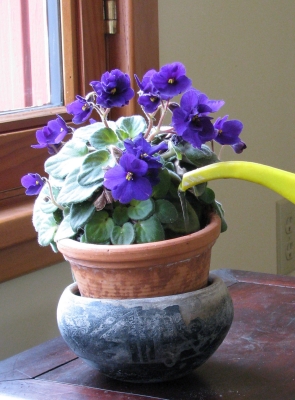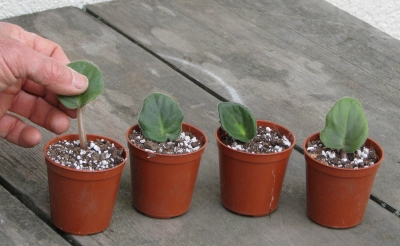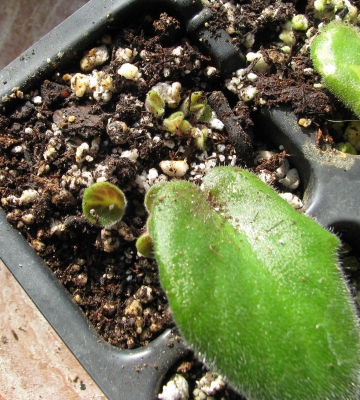FLOWERS ALL WINTER
Mine Aren’t Frilly
And now, with a bow to my feminine side, a little something about African violets, houseplants that have traditionally been thought of as old lady’s flowers. Still, I’ll admit it, I like African violets. They offer so much for what little effort I make in growing them.
Mainly, what they offer is flowers, and at a time — now and throughout fall and winter — when flowers are at a premium. I have only one variety, but if I was really into African violets, I could be choosing plants with white, pink, blue, or purple flowers, or blue with white picotee, or white blushed pink, or . . . any one of a number of flower colors and color combinations. And then there are varieties with ruffled, scalloped, quilted, or variegated leaves. And plants that range from few-inch wide miniatures to over a foot-wide large.
My African violets are standard issue blue-flowered, flat-leafed, medium sized plants.
As I said, I put little effort into growing them.
If you study up on growing African violets, though, you’d think them very exacting in their requirements. For starters, they’re said to need special potting soil, well-drained but, with the addition of extra peat or sphagnum moss, consistently moist. They’re said to need bright light, preferably a north or west facing window, or fluorescent, but not too bright. Direct sun will allegedly burn their leaves. Avoid getting water on the leaves or it will leave a dark spot. Avoid getting water at the base of the plant (the crown) or it will rot. Avoid overwatering. Avoid underwatering. Oh, and I almost forgot to mention: Avoid cold water.
Moving on to the air around the plants . . . avoid chilling the plants, moving them away from cold windows at night or stuffing some newspaper between the plants and the window. But also don’t keep the plants too warm. Also, ramp up the humidity by growing them in the basement or setting them above trays filled with pebbles and water.
Whew! That’s effort. I don’t do any of that. I use the same potting soil for African violets as for all my other plants (except succulents), from tomato seedlings to fig trees to bonsai Ficus. My plants sit happily in south and west windows, some in a cold room with nothing to stop the flow of cold from the the glass. My watering is whimsical, leaving them sometimes sitting in too much water and other times in bone-dry soil. I pay no special attention to water temperature or to whether or not water gets on the leaves.
My African violets are growing and flowering just fine.
Leaves into Plants
Perhaps my African violets grow too well because every a couple of years or so they get so overgrown that they’re spilling up and out of their pots. Then it’s time for one of the coolest things about growing them, and that’s propagating them.
 I do so by cuttings, but not by the usual stem cuttings. African violets hardly have a stem; the crown, or whorl of leaves, is a foreshortening stem, too short for a stem cutting. I propagate them with leaf cuttings, typically taken in spring. Nothing complicated here: Just pull off some leaves and poke the leaf stalks (petioles) into a rooting mix of potting soil or equal parts peat and perlite. Water thoroughly, make a plastic tent or use an upturned, clear jar to maintain humidity, and move the whole setup to a bright location (definitely not full sun this time, or plants might cook!).
I do so by cuttings, but not by the usual stem cuttings. African violets hardly have a stem; the crown, or whorl of leaves, is a foreshortening stem, too short for a stem cutting. I propagate them with leaf cuttings, typically taken in spring. Nothing complicated here: Just pull off some leaves and poke the leaf stalks (petioles) into a rooting mix of potting soil or equal parts peat and perlite. Water thoroughly, make a plastic tent or use an upturned, clear jar to maintain humidity, and move the whole setup to a bright location (definitely not full sun this time, or plants might cook!).

African violet leaves, rooted
All that’s needed is patience. In a few weeks, from the bases of the leaf stalks appear new shoots, on their way to becoming whole, new plants. Fascinating.
Leaves into Plants, Another Way
A few years back I sowed dust-like seeds from a begonia plant. The seedlings matured into a few plants that were mounds of green, dripping all summer long with fire-engine red blossoms. I cloned the plants with stem cuttings, which took up a lot of space and were slow to root. So, I’m thinking, why not leaf cuttings for the begonias also, this spring?
Begonias can be multiplied by cutting the fleshier parts of leaves into triangular sections, each with a major vein, and sticking each triangle upright in a rooting mix. Or, another approach is to cut across the large veins on the undersurface of a begonia leaf, then lay the whole leaf on the rooting mix, pinning it down to maintain contact with the mix. In either case, with moisture, a clear tent, bright light, etc., roots and new plants develop. Again, fascinating.
Any Cell Can Do It
The reason that I or you can make a whole new plant from part of a plant is because of totipotence. This ten dollar word tells that any cell in a plant, except reproductive (egg and sperm) cells, houses identical genetic information, and that information can give rise to any other part of a plant, even to a whole new plant. It’s up to the skilled gardener to provide the conditions that prompt a plant part to develop into a whole new plant.






